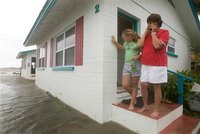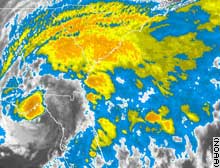
TAMPA, Fla. - The first named storm of the 2006 Atlantic hurricane season slightly strengthened early Monday in the Gulf of Mexico, prompting forecasters to issue tropical storm warnings for Florida's west coast.
Tropical Storm Alberto had maximum sustained wind near 50 mph but was not likely to grow into a hurricane, the National Hurricane Center said. There were no major reports of damage.
At 5 a.m. EDT, Alberto was centered about 275 miles south-southwest of Apalachicola. It was moving north-northeast at about 8 mph and could make landfall Tuesday night, forecasters said.
"Right before landfall they expect a little stronger: 55 gusts to 65. It won't be quite hurricane strength," said Ron Goodman, a meteorologist at the National Hurricane Center. "Things can change, but right now it's not expected to be a hurricane."
Forecasters said that up to 30 inches of rain could fall over some parts of Cuba, creating a threat of flash floods and mudslides, and that 5 to 10 inches could fall over the Florida peninsula through Tuesday. Over the Florida Keys, between 3 to 5 inches of rainfall are possible.
A tropical storm warning was issued for most of Florida's west coast, from Englewood to Indian Pass, meaning tropical storm conditions were expected there within the next 24 hours. A tropical storm watch remains in effect from south of Englewood to Bonita Beach.
The tropical depression that produced Alberto formed Saturday, nine days after the official start of the hurricane season, in the northwest Caribbean, which can produce typically weak storms that follow a similar track this time of year, forecasters said.
Last year's hurricane season was the most destructive on record. Hurricane Katrina devastated Louisiana and Mississippi and was blamed for more than 1,570 deaths among Louisiana residents alone.
This year, however, meteorologists have said the Atlantic is not as warm as it was at this time in 2005, meaning potential storms would have less of the energy needed to develop into hurricanes.
Last year's first named storm was Tropical Storm Arlene, which formed June 9 and made landfall just west of Pensacola in the Florida Panhandle.
 After splashing ashore in Florida without its once-feared punch, the remnants of the first named storm of the season churned through the Southeast early Wednesday, bringing much-needed rain and offering a tune-up for officials readying for the long hurricane season.
After splashing ashore in Florida without its once-feared punch, the remnants of the first named storm of the season churned through the Southeast early Wednesday, bringing much-needed rain and offering a tune-up for officials readying for the long hurricane season. 




